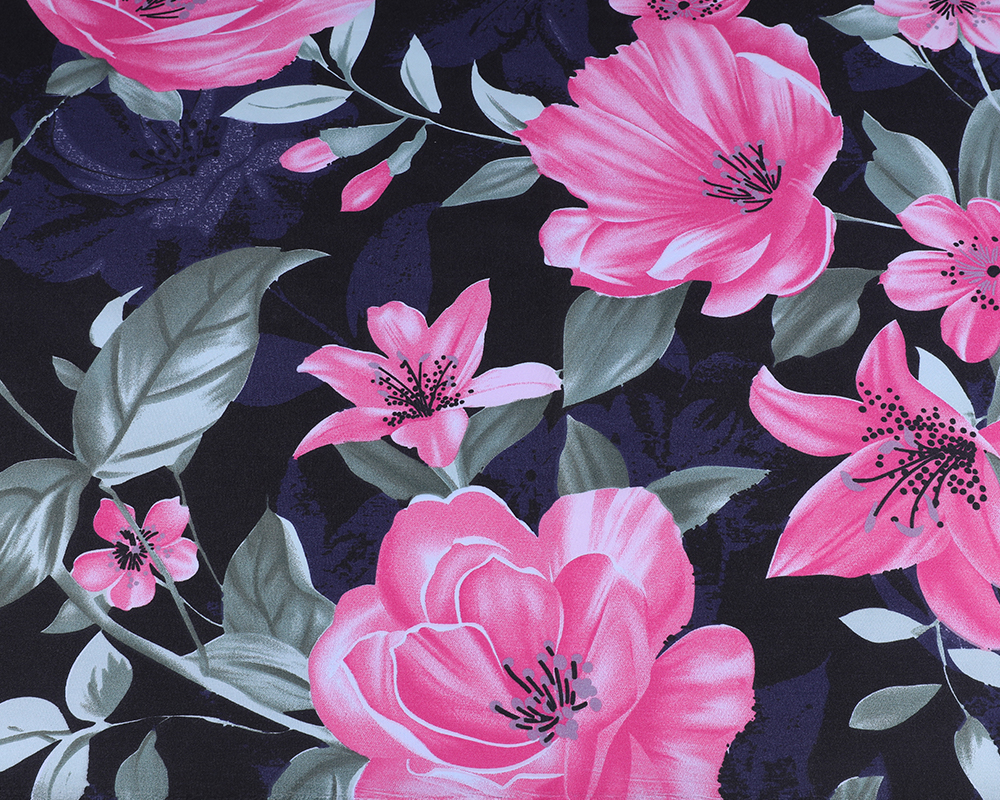Search...
To improve the color retention of 100% Polyester Printed Fabric after repeated washing and avoid color fading and print shedding, the key lies in choosing the right dye, printing process, post-treatment method and appropriate washing precautions.
Disperse dyes are dyes specifically used for polyester fibers. They can adhere well to polyester fibers and have high color fastness, especially under hot water washing and strong friction. Choosing disperse dyes can improve the color fastness and anti-fading properties of fabrics.
For some specific polyester fabrics, acid dyes can also provide strong adhesion and improve the color stability after dyeing.
The thermal transfer process transfers the printed pattern to the fabric through heat pressing, which can ensure that the print and the fiber are firmly combined. This method usually has high color fastness, especially in avoiding fading and print shedding.
Modern digital printing technology can print patterns directly on polyester fabrics, with high precision and long-lasting patterns that are not easy to fall off. By controlling the composition and quality of printing inks, the durability of the printing effect can be further improved.
After printing, the color fixation treatment is carried out to ensure that the printed pattern can be firmly fixed on the polyester fiber to prevent the printing from falling off due to factors such as washing and friction. The color fixation treatment can be completed by using a suitable fixing agent.
Covering the printed fabric with a special post-treatment coating (such as waterproof and anti-fading coating) can enhance its anti-washing and anti-ultraviolet properties and further improve color fastness.
Strengthening the structure of polyester fibers through chemical cross-linking technology can make it tougher and avoid deformation or fading during repeated washing. Cross-linking treatment can also improve the oxidation resistance of polyester fabrics, so that it can maintain better color under high-temperature washing and high-humidity environments.
After special wear-resistant treatment, the surface structure of polyester fabrics is more dense and can resist damage during friction and washing, thereby improving the durability of printing.
Polyester fabrics are prone to color fading and aging when exposed to sunlight for a long time. By adding anti-ultraviolet additives during the production process, the damage of ultraviolet rays to dyes and fabrics can be reduced, thereby maintaining the color effect for a longer time.
Washing with too hot water will accelerate the fading of polyester fabrics and the shedding of prints, so it is recommended to use cold or warm water for washing, and avoid using hot water and soaking for a long time.

Neutral or mild detergents help protect fabrics and prints. Avoid using detergents containing bleach, strong acids or strong alkalis, as these chemical ingredients will accelerate the fading or shedding of prints.
There are detergents specifically for polyester or printed fabrics on the market, which can effectively protect the color and print effects of the fabric while washing.
To avoid strong friction between the fabric and other clothes during the washing process, polyester fabrics can be placed in a laundry bag for washing. This can effectively reduce the damage to the fabric and prints caused by friction.
Avoid using a dryer or high-temperature heating for drying. High temperatures may cause thermal deformation of polyester fabrics and affect the stability of the prints. Natural drying is the best choice, especially in a cool and ventilated place.
By applying waterproof and anti-fouling treatments, the durability of the fabric can be improved, the accumulation of stains can be reduced, and the frequency of washing can be reduced, thereby reducing the problem of color fading during washing. Waterproofing can also effectively protect the prints from the effects of washing.
Polyester fabrics are prone to static electricity, especially in dry environments. Static electricity may cause dust or fine particles to adhere to the surface of the fabric, affecting the printing effect. Antistatic treatment can reduce static electricity accumulation, keep the fabric clean, and improve its durability.
The quality of polyester fabrics directly affects the printing effect and color fastness. In order to improve the durability of printed fabrics, it is particularly important to choose high-quality polyester fibers:
Choosing high-quality polyester fibers can reduce defects in the production process and ensure the flatness of the fabric and the uniformity of dyeing. High-quality raw materials help improve the adhesion of dyes and the durability of colors.
Using finely woven polyester fabrics can make the printed pattern more delicate and reduce color fading and pattern shedding caused by uneven fiber surface.
To improve the color retention of 100% Polyester Printed Fabric after repeated washing and avoid color fading and print shedding, it is necessary to comprehensively consider multiple aspects such as dye selection, printing process, post-processing technology, and washing methods. Choosing high-quality dyes and appropriate printing processes, optimizing fiber processing and fabric finishing, adopting professional washing protection measures, and using high-quality basic fabrics are all effective ways to ensure the durability and color stability of polyester printed fabrics. Through these comprehensive measures, not only can the service life of the fabric be extended, but its beauty and functionality can also be guaranteed during long-term use.

 English
English
 中文简体
中文简体
 Español
Español





.jpg?imageView2/2/format/jp2)






